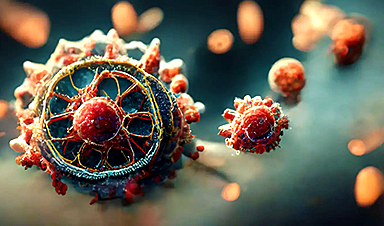Scientists have illuminated the process by which a highly infectious virus, recently transmitted from animals to humans, gains entry into human cells.
Dr. Isaacs said the virus caused fever and severe respiratory symptoms and was from the same class of viruses as the deadly Nipah and Hendra viruses.
“It’s important we understand the inner workings of these emerging viruses, which is where our work comes in.”

The research team in front of UQ’s cryogenic electron microscope, L-R Dr. Ariel Isaacs, Associate Professor Daniel Watterson, Dr. Naphak Modhiran, and Dr. Yu Shang Low. Credit: The University of Queensland
The team used UQ’s molecular clamp technology to hold the fusion protein of the Langya virus in place to uncover the atomic structure using cryogenic electron microscopy at UQ’s Centre for Microscopy & Microanalysis.
“Understanding the structure and how it enters cells is a critical step towards developing vaccines and treatments to combat Henipavirus infections,” Dr. Isaacs said.
“There are currently no treatments or vaccines for them, and they have the potential to cause a widespread outbreak.”
Associate Professor Daniel Watterson, a senior researcher on the project, said they also saw that the Langya virus fusion protein structure is similar to the deadly Hendra virus, which first emerged in southeast Queensland in 1994.
“These are viruses that can cause severe disease and have the potential to get out of control if we’re not properly prepared,” Dr Watterson said.
“We saw with COVID-19 how unprepared the world was for a widespread viral outbreak and we want to be better equipped for the next outbreak.”
The researchers will now work to develop broad-spectrum human vaccines and treatments for Henipaviruses, such as Langya, Nipah, and Hendra.
Reference: “Structure and antigenicity of divergent Henipavirus fusion glycoproteins” by Ariel Isaacs, Yu Shang Low, Kyle L. Macauslane, Joy Seitanidou, Cassandra L. Pegg, Stacey T. M. Cheung, Benjamin Liang, Connor A. P. Scott, Michael J. Landsberg, Benjamin L. Schulz, Keith J. Chappell, Naphak Modhiran and Daniel Watterson, 16 June 2023, Nature Communications.
DOI: 10.1038/s41467-023-39278-8
UQ acknowledges the support of the Coalition for Epidemic Preparedness Innovations, the Queensland and Australian governments and philanthropic partners.
News
Nanocrystals Carrying Radioisotopes Offer New Hope for Cancer Treatment
The Science Scientists have developed tiny nanocrystal particles made up of isotopes of the elements lanthanum, vanadium, and oxygen for use in treating cancer. These crystals are smaller than many microbes and can carry isotopes of [...]
New Once-a-Week Shot Promises Life-Changing Relief for Parkinson’s Patients
A once-a-week shot from Australian scientists could spare people with Parkinson’s the grind of taking pills several times a day. The tiny, biodegradable gel sits under the skin and releases steady doses of two [...]
Weekly injectable drug offers hope for Parkinson’s patients
A new weekly injectable drug could transform the lives of more than eight million people living with Parkinson's disease, potentially replacing the need for multiple daily tablets. Scientists from the University of South Australia [...]
Most Plastic in the Ocean Is Invisible—And Deadly
Nanoplastics—particles smaller than a human hair—can pass through cell walls and enter the food web. New research suggest 27 million metric tons of nanoplastics are spread across just the top layer of the North [...]
Repurposed drugs could calm the immune system’s response to nanomedicine
An international study led by researchers at the University of Colorado Anschutz Medical Campus has identified a promising strategy to enhance the safety of nanomedicines, advanced therapies often used in cancer and vaccine treatments, [...]
Nano-Enhanced Hydrogel Strategies for Cartilage Repair
A recent article in Engineering describes the development of a protein-based nanocomposite hydrogel designed to deliver two therapeutic agents—dexamethasone (Dex) and kartogenin (KGN)—to support cartilage repair. The hydrogel is engineered to modulate immune responses and promote [...]
New Cancer Drug Blocks Tumors Without Debilitating Side Effects
A new drug targets RAS-PI3Kα pathways without harmful side effects. It was developed using high-performance computing and AI. A new cancer drug candidate, developed through a collaboration between Lawrence Livermore National Laboratory (LLNL), BridgeBio Oncology [...]
Scientists Are Pretty Close to Replicating the First Thing That Ever Lived
For 400 million years, a leading hypothesis claims, Earth was an “RNA World,” meaning that life must’ve first replicated from RNA before the arrival of proteins and DNA. Unfortunately, scientists have failed to find [...]
Why ‘Peniaphobia’ Is Exploding Among Young People (And Why We Should Be Concerned)
An insidious illness is taking hold among a growing proportion of young people. Little known to the general public, peniaphobia—the fear of becoming poor—is gaining ground among teens and young adults. Discover the causes [...]
Team finds flawed data in recent study relevant to coronavirus antiviral development
The COVID pandemic illustrated how urgently we need antiviral medications capable of treating coronavirus infections. To aid this effort, researchers quickly homed in on part of SARS-CoV-2's molecular structure known as the NiRAN domain—an [...]
Drug-Coated Neural Implants Reduce Immune Rejection
Summary: A new study shows that coating neural prosthetic implants with the anti-inflammatory drug dexamethasone helps reduce the body’s immune response and scar tissue formation. This strategy enhances the long-term performance and stability of electrodes [...]
Scientists discover cancer-fighting bacteria that ‘soak up’ forever chemicals in the body
A family of healthy bacteria may help 'soak up' toxic forever chemicals in the body, warding off their cancerous effects. Forever chemicals, also known as PFAS (per- and polyfluoroalkyl substances), are toxic chemicals that [...]
Johns Hopkins Researchers Uncover a New Way To Kill Cancer Cells
A new study reveals that blocking ribosomal RNA production rewires cancer cell behavior and could help treat genetically unstable tumors. Researchers at the Johns Hopkins Kimmel Cancer Center and the Department of Radiation Oncology and Molecular [...]
AI matches doctors in mapping lung tumors for radiation therapy
In radiation therapy, precision can save lives. Oncologists must carefully map the size and location of a tumor before delivering high-dose radiation to destroy cancer cells while sparing healthy tissue. But this process, called [...]
Scientists Finally “See” Key Protein That Controls Inflammation
Researchers used advanced microscopy to uncover important protein structures. For the first time, two important protein structures in the human body are being visualized, thanks in part to cutting-edge technology at the University of [...]
AI tool detects 9 types of dementia from a single brain scan
Mayo Clinic researchers have developed a new artificial intelligence (AI) tool that helps clinicians identify brain activity patterns linked to nine types of dementia, including Alzheimer's disease, using a single, widely available scan—a transformative [...]





















